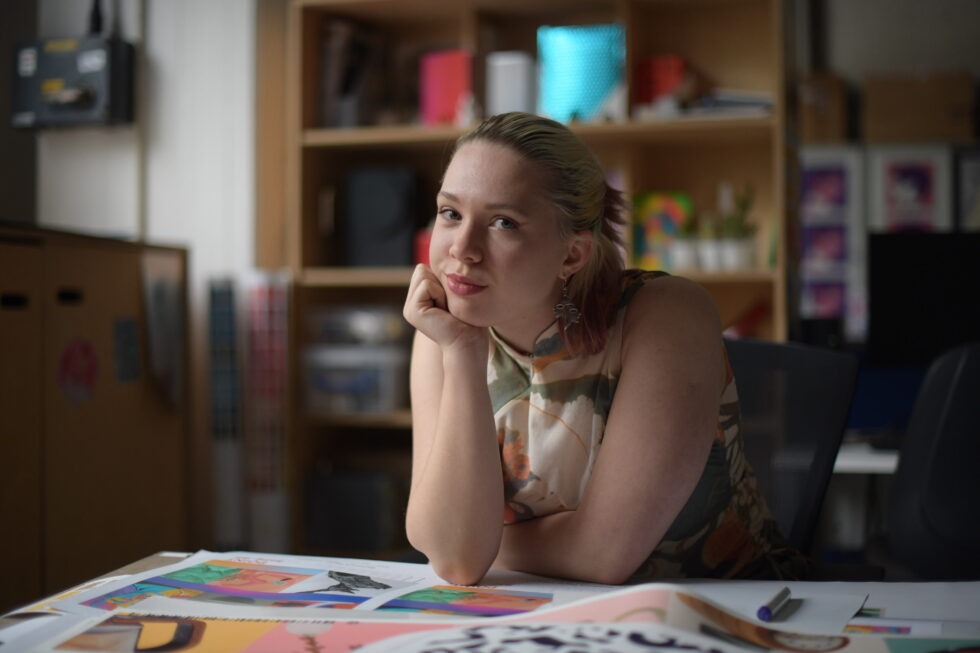Exploring Mia Upton’s Textile Artistry
This piece delves into the creative world of Mia Upton, whose work weaves together cultural heritage and contemporary textile design. At the heart of her practice lies a powerful dialogue between traditional weaving techniques and bold, modern expressions, all rooted in her Scottish and Hong Kong backgrounds.
Showcasing Craft at Cambridge’s Fitzwilliam Museum
In the summer of 2025, Mia was one of six featured artists in the Up & Coming Artists programme, held at the Fitzwilliam Museum and Cambridge Open Studios. Over two weekends, she set up her traditional loom within the museum’s refurbished studio space, giving visitors an intimate look at the weaving process — from observing to hands-on attempts.
Her installations featured patterns inspired by museum objects, designed deliberately with thick yarn for swift, visible progress that intrigued both children and adults. The joy of watching a textile materialize from simple threads proved contagious, reconnecting an audience with the tactile and meditative nature of weaving.
Weaving Heritage and Personal Identity
Mia’s artistic narrative draws heavily on her dual heritage and personal identity struggles. With roots in Scottish lineage and a childhood in Hong Kong, her textiles become a canvas for exploring themes of belonging and culture. By reinterpreting traditional tartan—a symbol historically limited to male wearers—she challenges gender norms and reclaims weaving as a feminist craft.
She experiments with color and pattern, notably incorporating pink hues to subvert traditional gender associations. Additionally, she integrates Hong Kong’s maritime culture by translating fishing net forms into textile motifs dyed with indigo, creating a meaningful fusion of Scottish and Hong Kong traditions.
A Brief Look at the History of Textile Craft
Textile arts hold a central place in civilizations globally; they frequently signify cultural identities and social histories. Traditional crafts like weaving developed alongside agricultural advances, with communities cultivating fibers such as wool and linen. These textiles not only served practical purposes but became markers of heritage, skilled labor, and artistic expression.
Yet, modern times have ushered in challenges. The rise of fast fashion in the late 20th century dramatically affected the textile industry, leading to the closure of many mills and a sharp decline in artisan training programs. This rapid consumption culture conflicts with the slow, deliberate rhythms of weaving, underscoring the importance of artists dedicated to preserving these crafts.
Textile Craft as a Form of Cultural Storytelling
Throughout history, textiles have served as storytelling vessels, carrying motifs and methods from generation to generation. The reworking of traditional patterns, like tartan, allows contemporary artists not only to honour but also to reinterpret and evolve cultural narratives, inviting viewers to engage in identity conversations beyond mere aesthetics.
Contemporary Relevance and Future Outlook
The rekindling of interest in heritage textiles aligns with broader trends in cultural tourism, where visitors seek authentic experiences tied to local traditions and creativity. Museums and studios showcasing living crafts like weaving enrich the cultural fabric of destinations, offering unique, immersive activities that connect travelers directly with the artistic heritage of a place.
In tourism contexts, crafts such as Mia’s work create meaningful encounters that foster cultural understanding and local pride. As global travelers increasingly prize authenticity and sustainable experiences, textile arts stand to regain their prominence both as revered cultural heritage and as contemporary art forms.
Key Highlights of Mia Upton’s Textile Practice
- Uses traditional looms with modern design elements to engage broad audiences.
- Reimagines heritage patterns like tartan to explore feminist and identity themes.
- Draws inspiration from Scottish and Hong Kong cultural symbols, such as fishing nets.
- Provides interactive demonstrations that make textile arts accessible and engaging.
- Champions the slow, meditative process of weaving in contrast to fast-fashion culture.
| Görünüm | Description |
|---|---|
| Origin of Interest | Inspired by traditional weaving techniques witnessed in Malawi. |
| Artistic Themes | Identity, heritage, gender, cultural fusion. |
| Materials Used | Thick yarn, indigo dye, traditional weaving tools. |
| Exhibition Venue | Fitzwilliam Museum, Cambridge. |
| Educational Aspect | Hands-on workshops and public demonstrations. |
Handcrafts such as weaving play a critical role in linking past and present cultural identities, helping preserve valuable heritage while adapting it for modern audiences. The revival of these skills supports more sustainable and meaningful tourism experiences, highlighting the importance of thoughtful cultural production.
For those drawn to exploring destinations where art, tradition, and nature meet—whether by the sea, lake, or bustling cultural hubs—the connection to local crafts enriches every journey. GetBoat GetBoat.com keeps a keen eye on such developments worldwide. As an international marketplace for renting sailing boats and yachts, GetBoat offers a way to travel, explore, and experience these cultural treasures from the water, blending maritime adventure with the discovery of heritage and creativity. Yacht charters and boating excursions near museums and artisanal centers offer unique opportunities to immerse oneself in both nature and culture, making any trip truly unforgettable.

 Mia Upton’s Textile Creations: Tradition, Identity, and Innovation">
Mia Upton’s Textile Creations: Tradition, Identity, and Innovation">
